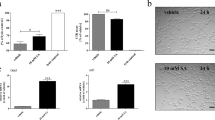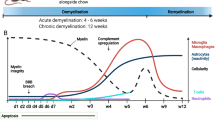Abstract
The aim of this study was to identify events that might take place in oligodendrocytes early in the process of demyelination, i.e., before the occurrence of massive loss of myelin. It was considered important to focus on demyelination and remyelination in young adults, in whose brains there would be relatively few juvenile glial precursor cells. CAII mRNA and protein were used to monitor changes in oligodendrocytes during cuprizone intoxication in the mice. After four or eight weeks of cuprizone feeding CAII message became less plentiful in oligodendrocyte processes. Two days after removal of cuprizone CAII message had appeared in those cell processes. Four or eight weeks after beginning cuprizone feeding CAII protein had decreased∼25% in forebrain homogenates. The loss of CAII protein was reversible after four weeks on cuprizone, but not after eight weeks. After four weeks of cuprizone feeding the numbers of CAII mRNA-prositive oligodendrocytes had decreased by ∼50%m and after eight weeks, by ∼80%. By 12 weeks, however, the number of oligodendrocytes expressing CAII mRNA had spontaneously returned to normal levels. Before eight weeks of cuprizone feeding, loss of myelinated tracts in the corpus striatum was reversible. Demyelination appreared to become irreversible after nine weeks of intoxication, although expression of CAII mRNA remained reversible. The results suggest that in the brain of the young adult, oligodendrocytes expressing message for CAII can be generated spontaneously shortly before demyelination becomes irreversible, and can survive and continue to express CAII mRNA but not CAII protein.
Similar content being viewed by others
References
Norton, W. T., Aquino, D. A., Hozumi, I., Chiu, F.-C., and Brosnan, C. F. 1992. Quantitative aspects of reactive gliosis: A review. Neurochem. Res. 17:877–885.
Morell, P. 1994. Biochemical and molecular basis of myelinopathy. Pages 583–608,in Chang, L. W. (ed.), Principles of Neurotoxicology, Marcel Dekker, Inc., New York.
Suzuki, K., and Kikkawa, Y. 1969. Status spongiosus of CNS and hepatic changes induced by cuprizone (biscyclohexanone oxalyldihydrazone). Am. J. Pathol. 54:307–323.
Blakemore, W. F. 1972. Observations on oligodendrocyte degeneration, the resolution of status spongiosus and remyelination in cuprizone intoxication in mice. J. Neurocytol. 1:413–426.
Ludwin, S. K. 1978. Central nervous system demyelination and remyelination in the mouse. Lab. Invest. 39:597–612.
Blakemore, W. F. 1973. Remyelination of the superior cerebellar peduncle in the mouse following demyelination induced by feeding cuprizone. J. Neurol. Sci. 20:73–83.
Ludwin, S. K. 1979. An autoradiographic study of cellular proliferation in remyelination of the central nervous system. Am. J. Pathol. 95:683–696.
Wood, P., and Bunge, R. P. 1984. The biology of the oligodendrocyte. Pages 1–46,in Norton, W. T. (ed.), Oligodendroglia. Advances in Neurochemistry, Vol. 5, Plenum Press, New York.
Blakemore, W. F. 1984. The response of oligodendrocytes to chemical injury. Acta Neurol. Scand. 70:33–38.
Ludwin, S. K., and Sternberger, N. H. 1984. An immunohistochemical study of myelin proteins during remyelination in the central nervous system. Acta Neuropathol. (Berl.) 63:240–248.
Cammer, W., and Zhang, H. 1993. Atypical localization of the oligodendrocytic isoform (PI) of glutathione-S-transferase in astrocytes during cuprizone intoxication. J. Neurosci. Res. 36:183–190.
Witham, B. (ed.) 1993, Jax Notes, p. 2.
Snell, G. D. 1956. Reproduction. Pages 55–88,in Snell, G. D. (ed.), Biology of the Laboratory Mouse, 1st edition, Roscoe B. Jackson Memorial Laboratory, Dover Publications, Inc., New York.
Sapirstein, V. S., and Lees, M. B. 1978. Purification of myelin carbonic anhydrase. J. Neurochem. 31:505–511.
Curtis, P. J., Withers, E., Demuth, D., Watt, R., Venta, P. J., and Tashian, R. E. 1983. The nucleotide sequence and derived amino acid sequence of cDNA coding for mouse carbonic anhydrase II. Gene 25:325–332.
Melton, D. A., Krieg, P. A., Rebagliati, M. R., Maniatis, T., Zinn, K., and Green, M. R. 1984. Efficient in vitro synthesis of biologically active RNA and RNA hybridization probes from plasmids containing a bacteriophage SP6 promoter. Nucleic Acids Res. 12:7035–7056.
Laemmli, U. K. 1970. Cleavage of structural proteins during the assembly of the head of bacteriophage T4. Nature 337:680–685.
Towbin, H., Staehelin, T., and Gordon, J. 1979. Electrophoretic transfer of proteins from polyacrylamide gels to nitrocellulose sheets: procedure and some applications. Proc. Natl. Acad. Sci. USA 76:4350–4354.
Tansey, F. A., Thampy, K. G., and Cammer, W. 1988. Acetyl-CoA carboxylase in rat brain: 2. Immunocytochemical localization. Develop. Brain Res. 43:131–138.
Angerer, L. M., Stoler, M. H., and Angerer, R. C. 1987. In situ hybridization with RNA probes: An annotated recipe. Pages 42–70,in Valentino, K. L., Eberwine, J. H., and Barchas, J. D. (eds.), In Situ Hybridization, Oxford University Press, New York.
Brophy, P. J., Boccaccio, G. L., and Colman, D. R. 1993. The distribution of myelin basic protein mRNAs within myelinating oligodendrocytes. Trends in Neurosci. 16:515–521.
Colman, D. R., Kreibich, G., Frey, A. B., and Sabatini, D. D. 1982. Synthesis and incorporation of myelin polypeptides into CNS myelin. J. Cell Biol. 95:598–608.
Verity, A. N., and Campagnoni, A. T. 1988. Regional expression of myelin protein genes in the developing mouse brain: in situ hybridization studies. J. Neurosci. Res. 21:238–248.
Ludwin, S. K. 1989. Evolving concepts and issues in remyelination. Dev. Neurosci. 11:140–148.
Ludwin, S. K. 1980. Chronic demyelination inhibits remyelination in the central nervous system. Lab. Invest. 43:382–387.
Fujita, N., Ishiguro, H., Sato, S., Kurihara, T., Kuwano, R., Sakimura, K., Takahashi, Y., and Miyatake, T. 1990. Induction of myelin-associated glycoprotein mRNA in experimental remyelination. Brain Res. 513:152–155.
Author information
Authors and Affiliations
Additional information
Special issue dedicated to Dr. Marion E. Smith.
Rights and permissions
About this article
Cite this article
Tansey, F.A., Zhang, H. & Cammer, W. Expression of carbonic anhydrase II mRNA and protein in oligodendrocytes during toxic demyelination in the young adult mouse. Neurochem Res 21, 411–416 (1996). https://doi.org/10.1007/BF02527704
Accepted:
Issue Date:
DOI: https://doi.org/10.1007/BF02527704




